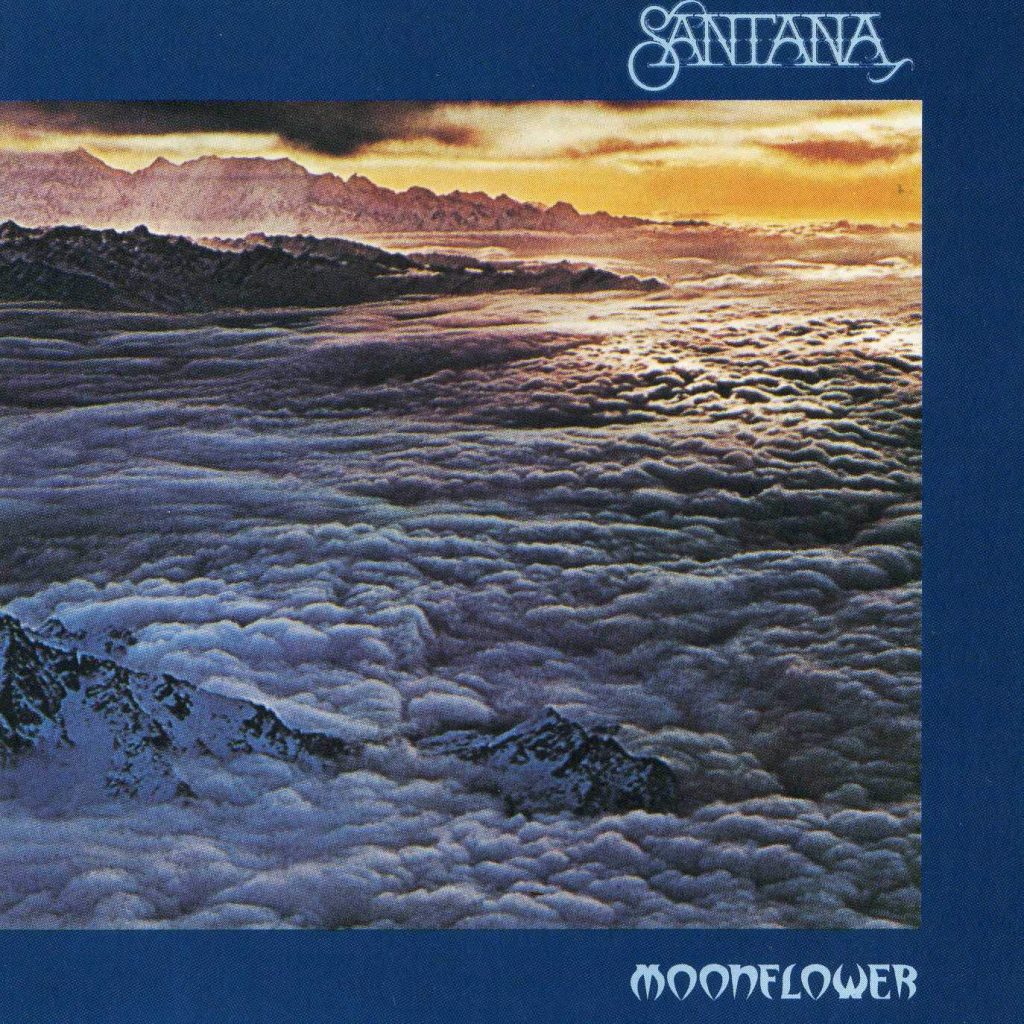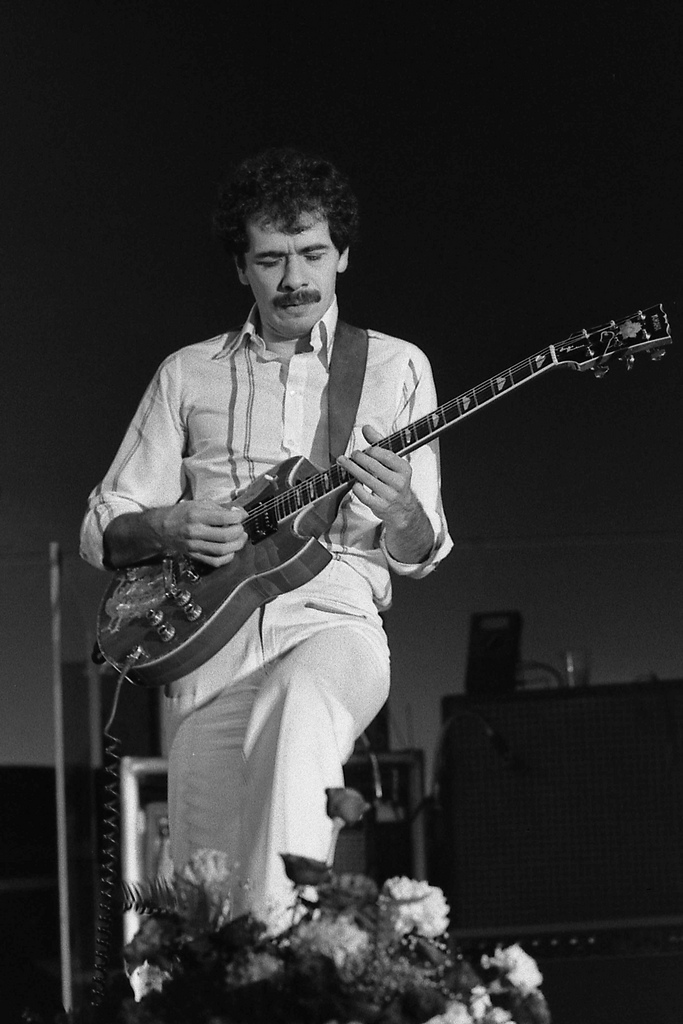
According to one reliable count, there have been more than 80 members of the band Santana since its founding in 1966. The brilliant, mercurial guitarist/songwriter Carlos Santana has always surrounded himself with top-notch musicians, but over his nearly 60 years as a bandleader he’s rarely hesitated to hire or fire in his quest to achieve greatness. He’s been in pursuit of nothing less than the sacred healing power of music.
After early success partly fueled by an appearance as an unknown at Woodstock and in the film of the festival, in 1977 Carlos Santana was often at odds with his longtime record label Columbia, where executives discouraged him from exploring musical styles—including, most particularly, jazz-fusion—they considered less commercial. Lotus, a now-revered triple-LP set recorded live in Japan in 1973, wasn’t allowed an American release for 17 years, and Columbia’s Clive Davis found Santana’s collaborations with John McLaughlin (Love Devotion Surrender) and Alice Coltrane (Illuminations) perplexing and distracting even as his label reluctantly released them. The last three proper Santana albums, Borboletta, Amigos and Festival, had sold poorly; the group hadn’t had a hit pop single for five years.
Some critics blamed the ever-changing personnel and changes in musical direction for the decline in the public’s interest, while others questioned Carlos’ increasing spiritual commitment to the guru Sri Chinmoy, who’d given his disciple the name Devadip, meaning “the lamp, light and eye of God.”
In John Tobler and Stuart Grundy’s book The Guitar Greats, Carlos explained his general philosophy: “Everyone’s entitled to their opinion, but at the same time, I’m the one that I have to satisfy, and it’s more important that I please myself than please the critics—look at the critics: they all like so and so band, whose album goes platinum, but who, by my standards, sucked, so you’ll always have differences of opinion. Santana will always be a band that finds it hard to please everybody.”

Carlos’ next move was the double-LP Moonflower, which combines live and studio tracks, and yielded a major pop single with a re-tooled version of Rod Argent’s “She’s Not There,” originally a hit for the Zombies in 1964. Carlos loved recording live, without what he called “the padding and makeup” of studio recordings: “I like live albums a lot, because out there you don’t have time to do anything else except just go, go for the heart.”
Exhibiting a remarkable humility, he told Sounds’ Mick Brown in 1976, “I don’t care whether or not I’m an innovator anymore. If it’s something old or something new it doesn’t matter as long as my heart’s in it. A lot of people take a lot of time putting on a black cape and being mysterious about their music; people’ll say, ‘Far out,’ but they don’t really understand what it means. I care more for relating than innovating.”
On Moonflower, Greg Walker is the lead vocalist, Tom Coster handles keyboards, Graham Lear drums, and Raul Rekow plays congas, bongos and other percussion. For the eight studio tracks, recorded at CBS Recording Studios in San Francisco, David Margen is the bass player and Pete Escovedo adds timbales and other Latin instruments. On the eight live cuts, recorded in Germany, France and England, Pablo Tellez is the bassist and the veteran Jose “Chepito” Areas joins on percussion. Billed as “Devadip Carlos Santana,” the leader is as outstanding as ever on guitar, most often composing songs and instrumentals with Coster.
The live performances are nothing short of incendiary, with the driving salsa of “Dance Sister Dance”; the 13-minute showcase for the percussionists and organist Coster, “Savor/Toussaint L’Overture”; a sinuous medley, “Carnaval/Let The Children Play/Jugando”; the transcendent spirituality of the keening instrumental “Europa”; and a spectacular blast of Santana’s “Black Magic Woman/Gypsy Queen” pairing among the highlights. The guitar effects Carlos liberally employs are always in service to his heart-swelling emotional heft. As he told Sounds, “In the past there was a contradiction between what I wanted as a musician and what my audience wanted of me, but not now. I love rock and roll, vital music, and I love to explore too. But Guru told me something which I neglected to accept at the time, that quality and quantity will come together.”
Moonflower begins impressively, with Tom Coster’s smooth-jazz-and-funk groover “Dawn” as instrumental overture to Carlos’ “Go Within.” Of the other studio recordings, Carlos’ solo compositions “I’ll Be Waiting” and “Transcendence” clearly show the influence of Earth, Wind & Fire, with whom Santana toured. Walker is a terrific R&B singer, and his smooth style brings out some of the group’s tenderest playing, although Carlos is always ready to kick up the tempo and wail in the upper register of his Yamaha SG, as he does on “Transcendence.”
The instrumental “Zulu” was written by Carlos with Tommy Coster Jr., who at the age of 11 was already beginning his own music career. It features Tom Coster, who commands a variety of acoustic keyboards and synthesizers, including Arp Omni, Fender Rhodes and Yamaha Electric Grand, playing with his son on the Arp DGX Pro Soloist. “Bahia,” a kicky little piece that cleverly wraps Coster’s keyboards around Santana’s guitar lines, and “El Morocco,” which adds a little Miles Davis homage, are also first-rate.
“She’s Not There” benefits mightily from the vibes/marimba combination Tom Coster plays, and the scratch of the hand-held guiro of Escovedo. Carlos’ middle solo takes off in high gear and never lets up during his relatively short moment in the spotlight, but he returns for another (highly-processed) solo before too long. The arrangement even quotes from “Soul Sacrifice,” the instrumental from Santana’s debut album, which also appears in a scorching live version on Moonflower. And a lot of credit goes to Walker for a terrific job pushing the lyrics with a very different approach than what Colin Blunstone used on the Zombies recording.
Mixing live and studio tracks was an unusual gambit, but it paid off for Santana; Moonflower, released in mid-October 1977, reached the top 10 on album sales charts in a dozen countries, including the United States, where it was ultimately certified double Platinum.
Although he’s had some health issues lately, Carlos Santana still leads a powerhouse band, now including his drummer wife Cindy Blackman Santana—he proposed on stage during a concert in Tinley Park, Illinois, on July 9, 2010. He’s had a residency at the House of Blues in Las Vegas for 11 years, and retains his fire as a guitarist, spiritual teacher and philanthropist. “Music is unity and harmony and it’s about healing,” he said during an awards ceremony recently. He’s talked about retiring, perhaps to become a full-time minister, but to date hasn’t followed through. In April 2023, Sony Pictures Classics announced it had acquired distribution rights for the Rudy Valdez-directed documentary Carlos, which will cover his entire career, from 14-year-old street musician to multiple Grammy Award winner.
Watch Santana perform “She’s Not There” live in 1977
Related: Our Album Rewind of Santana’s Abraxas
- Patti Smith’s ‘Horses’: Poetry In Motion - 05/21/2024
- Elton John ‘Honky Chateau’: New Heights - 05/19/2024
- Paul Simon ‘There Goes Rhymin’ Simon’: American Tunes - 05/05/2024


1 Comment
I remember if you wanted “Lotus” in the US in the 70s, it was pretty expensive.
Loved Santana’s late-70s and early-80s recordings such as “Moonflower” and “Zebop!”. Especially “Hannibal”.